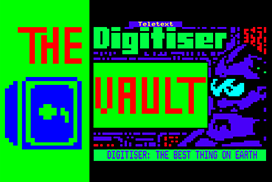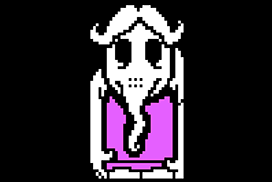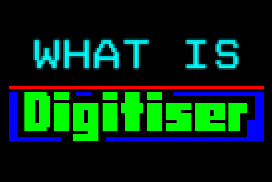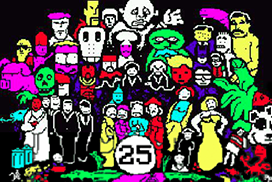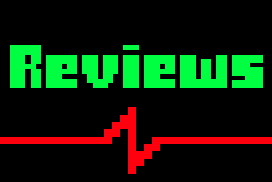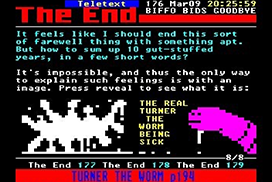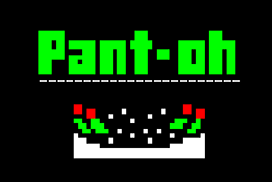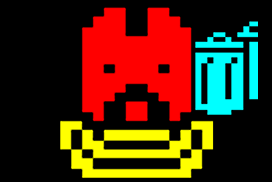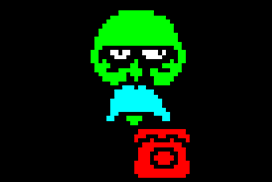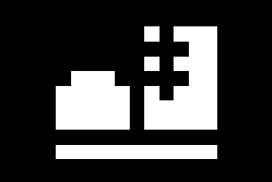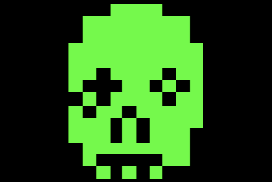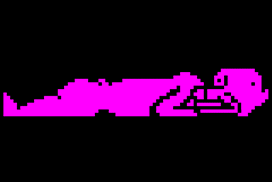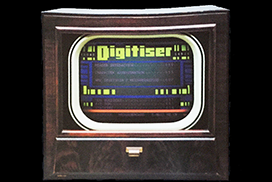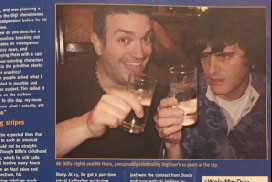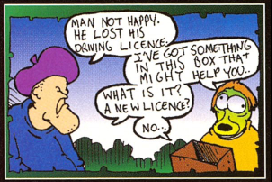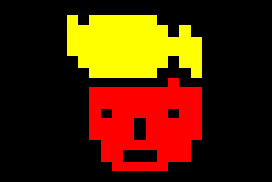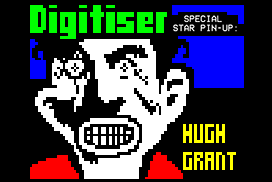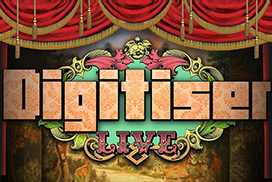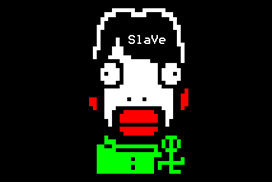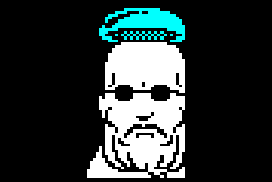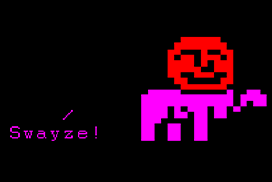
|
Wooooooh! Y'alright, our kid? I'm the ghost of that Tony Wilson from off of Manchester and that, which makes us dead trendy, yeah? I'm also dead full stop, but the afterlife is a bag o' shite - I'm too much of a geezer fer it, so I'm 'ere to introduce yer to these daft Digitiser FAQs instead.
I like to call 'em FAQ-58, which is a proper good joke and that, cos I'm a clever get, me. Yer 'avin' that, Shaun?
Wheel of Fortune, yer bastards!
- What is Digitiser?
- What is Teletext?
- When was Digitiser broadcast?
- What page number was Digitiser on?
- Who wrote Digitiser?
- Who is Mr Biffo?
- Who is Mr Hairs?
- Did Stuart Campbell write Digitiser's reviews?
- What happened to the writers?
- Is Digitiser still going today?
- Can I read Digitiser anywhere now?
- How is old teletext still being found today?
- How much of Digitiser has been saved?
- Was Digitiser popular?
- How many people read Digitiser?
- What was so special about Digitiser?
- What features did Digitiser have?
- Where did the team play the games they reviewed?
- Why was Digitiser so weird?
- Did Digitiser ever get into trouble?
- How was Digitiser seen by the games industry?
- Why did Digitiser fall out with Mean Machines Sega?
- Was Digitiser biased against Sega?
- Why did Digitiser hate the Amiga?
- Who created Digitiser's characters?
- How many characters did Digitiser have?
- Which Digitiser characters were the most popular?
- Who is The Man?
- Who wrote The Man's diary?
- What is The Man's Daddy?
- Is The Man's Daddy really The Man's daddy?
- Is The Man that appeared before and after his 1993 assassination the same Man?
- Was The Man really assassinated in November 1993?
- What was Turner The Worm?
- Who did Digitiser's graphics?
- Did Digitiser have any catchphrases?
- What does "Moc-moc-a-moc!" mean?
- What does "Huss!" mean?
- What does "press reveal" mean?
- What is a Reversible Sedgewick?
- Why do some characters have straps around their mouths?
- What's the significance of 72%?
- Were the Ring-sir! phone pranks real?
- Did Digitiser receive many letters from readers?
- What was Digigate?
- Why did Digitiser end on Teletext?
- Why did Teletext dislike Digitiser?
- Why did Mr Biffo disappear?
- Why was Digitiser2000 launched?
- What is Digitiser The Show?
- Are there any big-name fans of Digitiser?
- Who owns Digitiser?
- Where can I contact the Digitiser writers?
- Where can I learn how to recover teletext?
- I have some old video tapes that might contain Digitiser, can I send them anywhere for recovery?
- Why is this website called Super Page 58 when teletext pages were 3 digits long?
- When was this website created?
- Who runs this website?
- Why are you running a Digitiser fansite?
- How can I contact this website?
- Are there any other Digitiser fansites?
- Is there a Digitiser online community?
- Where can I learn more about Digitiser?
What is Digitiser?
Digitiser was originally a free daily computer and video games magazine, broadcast on UK teletext from 1 January 1993 to 9 March 2003.
It was beloved by fans for its surreal, subversive humour, with more than a touch of innuendo; along with the striking quality and honesty of its games journalism.
Digitiser continues today as a YouTube channel. It was originally revived in 2014 as the website Digitiser 2000, where Mr Biffo frequently posted new content. It was quietly taken offline in 2024, but is still accessible using the Wayback Machine.
A more detailed description of Digitiser can be found elsewhere on this site.
What is Teletext?
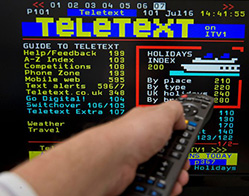
|
Known for its rudimentary, blocky graphics, as much as for the content itself, it could be considered to be a crude precursor to the internet.
The various services that were broadcast were incredibly popular, with millions of viewers tuning in throughout the 1980s, '90s, and early 2000s. In the UK, the BBC's Ceefax service ran for nearly 40 years until being discontinued in 2012 when the UK's analogue broadcast signal was switched off.
The UK's commercial stations had their own similar teletext services, beginning with Oracle on ITV and Channel 4, which was later superseded by Teletext (run by Teletext Ltd.) when Oracle lost their franchise at the end of 1992.
Each service was different, but all offered various standard pages and sections of news, sport, weather, TV listings, and subtitles accompanying the onscreen programme.
However, Teletext Ltd.'s service, which started on New Year's Day 1993 and ran until 2009, offered a broad range of other features and was more akin to a magazine than Ceefax's dry stuffiness. Their service included music pages, a teens section, film reviews, a children's comic strip, and a fondly-remembered multiple-choice quiz called Bamboozle. Digitiser was part of this line-up, and slotted into Teletext's "total entertainment" brand.
While teletext is no longer broadcast on UK TV, it is still in use elsewhere around Europe. Amateur enthusiasts have even set up a genuine teletext service called Teefax, which is broadcast over the internet, and can be displayed on old teletext-equipped TVs with the aid of a Raspberry Pi plug computer.
When was Digitiser broadcast?
Digitiser was broadcast on Teletext from 1 January 1993 to 9 March 2003.
What page number was Digitiser on?
Digitiser started life being broadcast on ITV page 370, before quickly moving to Channel 4 page 470 on 28 February 1993. Channel 4 was Digitiser's home for the rest of its run.
It stayed on page 470 for some time, but moved again to page 170 in January 1997, then to page 670 on 10 August 1998.
It went to page 480 in October 1999, where it stayed until November 2002, at which point it settled into its final position of page 175, staying there until it ended on Teletext in March 2003 (Digitiser's successor, Game Central, took over from it on this same page).
Who wrote Digitiser?

|
While Rose and Moore did the bulk of the editorial writing for Digitiser, it always had other more peripheral contributors, starting with Adam Keeble ('Mr Cheese') – who was added to the team in early 1993 specifically to cover the Commodore Amiga. Gavin Lambert ('Mr Udders') and 'Sean' ('Mr Toast' – his surname is lost to history) supported Rose with the tips and charts pages from late 1996 until the end of Digitiser's Teletext run, which included writing the characters of Wired Child, Dennis: The Man Of Zinc, and other denizens of the tips pages.
Along with the regular team of writers, the weekend editions of Digitiser featured regular columns by prominent members of the UK games industry. Bad Influence TV presenter Violet Berlin was the first of these, contributing weekly features until 1996 when a four-weekly rotating line-up was announced, named Panel 4. Berlin alternated weekend columns with Amiga Power's Stuart Campbell, Edge Editor Tony Mott, Loaded Online's Adam Porter, and briefly, writer of Teletext's Online section, Leslie Bunder, when he took over from Porter.
Bunder's place in the roster was cancelled after just a few months following complaints from readers, and was replaced by a viewer-written column for the fourth week of the Panel 4 rotation, known as 'Your Panel 4'.
Digitiser featured viewer-written articles from its early days in the form of the 'Old Game: Here' and 'Your Game: Here' nostalgia strands, up to the regular weekend columns in its later post-Digigate years.
Who is Mr Biffo?
Mr Biffo is the alter ego of Digitiser writer, co-creator, and owner Paul Rose. He's the only member of the team to have written Digitiser over its entire life in all its forms, becoming the only lead writer in the wake of Mr Hairs' departure in April 1996. He runs the Digitiser YouTube channel, the website Digitiser2000.com (which was active from 2014 to 2024), and is the mastermind behind Digitiser The Show. Outside of his work on Digitiser, he's a successful screenwriter, specialising in scripts for children's TV, but has worked on many different projects over the years, across film, TV, and videogames.
Who is Mr Hairs?
Mr Hairs is the nom de Digi of Digitiser writer and co-creator Tim Moore. He was a key member of the team in Digi's early days, and was one of the main writers from its inception until he left Teletext in April 1996. Today, he's a successful travel writer, with a string of very funny books "under" his "belt".
Did Stuart Campbell write Digitiser's reviews?
No. Stuart Campbell never wrote any of Digitiser's reviews. He only ever contributed Panel 4 columns - an archive of which can be found on his website.
Digitiser's reviews were only ever written by Paul Rose, Tim Moore, and Adam Keeble.
What happened to the writers?
Mr Biffo runs Digitiser's modern incarnation, the Digitiser YouTube channel. He also ran the website Digitiser2000.com until it was taken offline in 2024, though it's still accessible via the Wayback Machine. Under his real name of Paul Rose he's a successful screenwriter, specialising in scripts for children's TV, but has worked on many different projects over the years across film, TV, and videogames.
Mr Hairs, aka Tim Moore, is now an award-winning travel writer, having authored a number of best-selling books.
Is Digitiser still going today?
It certainly is – Mr Biffo regularly publishes videos on the Digitiser YouTube channel. Digitiser was originally revived in 2014 as website Digitiser 2000, which is now offline but still available on the Wayback Machine. In 2018, Digitiser became a high-standard YouTube show, continuing and building on Digi's legacy for a new generation of fans.
Can I read Digitiser anywhere now?
Yes! Super Page 58 has a huge archive of original Digitiser teletext pages, as well as other transcribed content elsewhere on the site. The modern incarnations of Digitiser are a website and YouTube channel, both produced by Paul Rose (Mr Biffo).
How is old teletext still being found today?
A community of teletext enthusiasts exists that has discovered how to extract and reconstruct full pages of original teletext from video tape recordings of TV programmes that included a teletext signal. This was previously thought to be impossible, and the content lost forever.
Efforts are being made to retrieve and archive as much teletext content as possible from old tapes, all of which can contain a teletext signal encoded in the recordings. It works for both VHS and Betamax systems, if you have compatible VCRs.
How much of Digitiser has been saved?
Around 60,000 individual pages from more than 1,800 separate editions of Digitiser's actual teletext pages, with a whole lot more saved as transcriptions of the text.
You can see them all in Super Page 58's Digitiser Vault image archive.
Was Digitiser popular?
Very! Digitiser was a big hit right from its launch, and only became more popular as it went along. At its height, 1.5 million viewers were reading Digitiser every week.
It quickly built up an ardent group of passionate fans, who tuned in every day, and later inspired an online community that birthed a number of fansites in the late '90s – like this very one you're reading now.
While it no longer boasts viewers in the millions, since its rebirth as a YouTube channel (and formerly a website, which was online from 2014 to 2024), Digitiser continues to bring in new fans, including many much younger than the original fans who read it on Teletext – a number of whom are still part of the Digitiser community today.
How many people read Digitiser?
According to industry figures, at its peak Digitiser boasted a readership of 1.5 million viewers per week. During the humour-free 'Digigate' era that spanned October 2001 to November 2002, this fell to "only" 400,000, before rebounding once the humour was restored – though not to the heights that it had previously enjoyed.
What was so special about Digitiser?
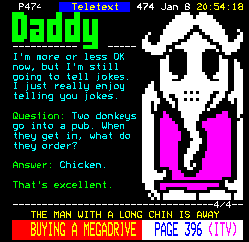
|
It's safe to say that Digitiser was unique. In the natural order of things, a teletext-based videogame magazine had no right being written to such a high standard as Digitiser.
It offered well-informed, well-considered reviews – often searing in their honesty, free from favour and influence – and became one of the most trusted sources of opinion and news throughout the UK games scene.
But that was merely a tiny fraction of the story. Digi's humour, its freewheeling insanity, the cast of characters, subversive jokes, and hilarious features combined to create something far beyond the sum of its parts.
For a certain generation of geeky British gamers, it was essential viewing, and the stuff of legend. The personalities of young readers were indelibly marked by it. Entire senses of humour developed and formed around its jokes.
It gave birth to a community, a common language, and a certain identity. Being a fan of Digitiser, in a world where print-based games magazines had the power, the glamour - and the screenshots - marked you out as a questioning free-thinker, who valued objectivity ahead of rehashed press releases, and who appreciated humour that was more than a little odd.
Digitiser commanded a dedicated, passionate fanbase willing to fight for its future when it was threatened, who felt that what was going on in this obscure, arcane corner of UK journalism, deserved to be preserved and enjoyed more widely.
Wrap all of that in with an against-the-odds story that reads like an underdog triumph (it really would make a great film), and you have something that nobody involved could have seen coming. A true phenomenon.
What features did Digitiser have?
When Digitiser launched, it offered gaming news, reviews, previews, a viewers' letters page, tips and cheats, and charts.
Over the years this expanded to include quizzes, quotes from industry figures, various one-off and recurring gaming features – and a slew of hilarious pieces that had little or no connection to games at all. These consisted of the likes of Ring-Sir! - a semi-regular transcript of prank phone calls to games shops – and the annual Digitiser Pant-oh – surreal spoofs of Christmas pantomimes.
Where did the team play the games they reviewed?

|
Some games were played at home, some at the Digi team's desks in the editorial office (Mr Biffo and Mr Hairs sat in the far corner seen in this image, featuring Teletext's first editorial director, John Holme on the right).
Most games were played in a small room downstairs in the Teletext office. This was deemed suitable as it was as far away from editorial staff as possible so they couldn't be disturbed, and as a result the music writers listened to their review material there as well.
Digi stopped using the room after a lot of their equipment was stolen from it, inlcuing a Nintendo Super Scope light gun that one of the security guards had recently been conspicuously "admiring"...
Why was Digitiser so weird?
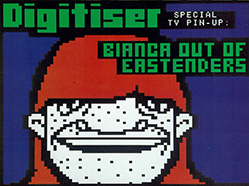
|
It should also be remembered that games journalism in the '90s was often humourous and tongue in cheek, across many magazines. It was a world away from the po-faced self-importance that passes for much modern games journalism.
Digitiser was about games – but this served only as a starting point to be subverted, a structure for the writers to hang their humour around. Initially this came from their desire to entertain – themselves, if not their readers – and eventually became an established part of its identity.
It's significant that Mr Biffo wrote Digitiser for its entire life – without him, it's unlikely its unique humour would, or could, have continued in the same way.
Did Digitiser ever get into trouble?
You… could say that. Beginning on the very first day of launch when they deigned not to cover the Amiga, causing a storm of outrage and fielding demands for the writers to be sacked, Digitiser has always had a knack for getting into a spot of bother.
Following the Amiga incident, an innocuous comment in a review of Street Fighter II lead to tabloid newspaper The Sun screaming about their 'sick videogame joke'; Mr Hairs was fired by Teletext Ltd after legal action was threatened over a news story; and they spent around a whole year publicly feuding with Mean Machines Sega.
Teletext bosses were always looking for ways to bring the maverick section into line, with shady plans made to replace the writers at various times (Mr Hairs' departure being down to needlessly sharp practice). These machinations culminated in Digi's humour being removed during the tragic events of the 'Digigate' era.
Despite, or perhaps even because of, these trials, Digi's popularity grew and became cemented in the minds of its readers, as proof of how anti-establishment and unique a publication it really was.
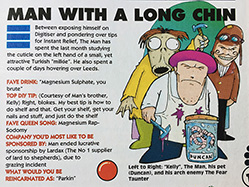
|
How was Digitiser seen by the games industry?
It varied to extremes – they had their friends, but they were also disliked intensely by others.
Future Publishing always had a good relationship with Digi, providing magazine subscriptions as prizes for Digi's weekly 'Hot Topic' letters page feature. Maverick were another publisher that got on well with them – so well, in fact, that they featured crossover Man With A Long Chin cartoons in their Super Control and Mega Drive Advanced Gaming titles.
Digitiser's most prominent industry supporter was Violet Berlin, presenter of ITV's video games show Bad Influence, and one of the faces of mainstream gaming during the 1990s. She would often arrange access for Digi that they wouldn't otherwise have been offered, and had them included on press outings and overseas trips.
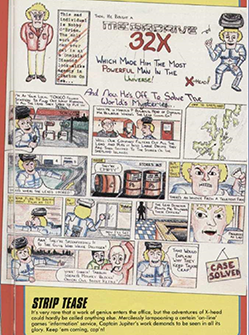
|
On the other hand, industry PR workers were suspicious of Digi and regarded it with disdain. They had an especially rocky relationship with Sega, and flat-out criticised Sony's PR rep by name in a news item after one incident.
The publications in EMAP's stable of magazines were very much in the camp of Digitiser's detractors. The official Sega Magazine and Mean Machines Sega both printed pages of vitriolic readers' letters, editorial insults, and (in the case of MMS) an unflattering cartoon, throughout a reciprocal feud that lasted a whole year.
Most significantly, Paragon's Dave Perry caused Tim Moore (Mr Hairs) to be fired by Teletext Ltd in April 1996 over a disputed news story (which he later admitted had been true).
Why did Digitiser fall out with Mean Machines Sega?
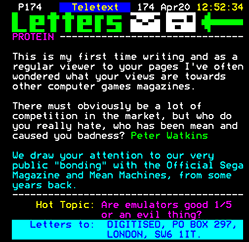
|
It began with MMS printing unflattering reader letters, accompanied by liberal amounts of insults aimed at Digi from the MMS staff in reply. Most of this seemed to stem from Digitiser's criticism of Sega and some of their flagship games, at a time when Sega was in the process of using one of its severed legs to cut off the other.
Until this point Sega had been imperious in the home console market, and commanded a horde of young fans as yet lacking in critical thinking faculties, and weren't able to accept that Digitiser's views might be justified.
Digi always enjoyed stirring the pot, and so hit back in their pages, leading to a tit-for-tat war that lasted over a year.
You can find out all about what went on elsewhere on this site.
Was Digitiser biased against Sega?
No. They were brutally honest, that's all – Digitiser's emergence on the gaming scene came at a transitional point for Sega, when they were all-conquering, but beginning to show signs of the hubris and poor decision-making that would lead to their drawn-out downfall. Digi weren't afraid of pointing out these failings, even in the face of vitriolic letters from Sega fanboys and sniping from Sega magazines.
They also weren't afraid of being rude in reply to said Sega fanboys - which doubtless served to entrench the views of their detractors.
That they would go onto be accused of bias against all the major console manufacturers over the years – sometimes at the same time, on the same letters page – underlines that this was just their approach, and that they "Hate everyone equally, man".
Why did Digitiser hate the Amiga?

|
They didn't hate the Amiga – they liked the machine well enough, and had enjoyed the games they'd played on the machine in the past. It was the computer's reactionary fans that they had a problem with.
The bad blood between Digi and Amiga owners started on literally day one of the magazine's life, with the announcement of their planned gaming coverage conspicuously failing to mention the Amiga.
This had been down to Digi launching on the wave of buzz and enthusiasm for the consoles of the era, where all the excitement and innovation seemed to be centred. Consoles were clearly the future. The PC was fast becoming a powerful games machine too, overcoming its clunky roots, and so that was also in the mix.
The Amiga, on the other hand, was seen as being on the wane – a fading format - and so didn't make the cut.
Plus, y'know - neither of the writers owned one. That may have had something to do with the policy decision as well, especially at a point where the team were having to build their reputation from scratch and scrounge games from wherever they could.
Only a few hours into its life, and Digitiser had already outraged an army of Amiga owners, who rang into Teletext in their droves demanding that the writers be sacked.
While this almighty shock wasn't enough to convince Digi that the Amiga had a long-term future, it did convince them to run Amiga reviews - if only to stem the flow of vitriol aimed in their direction.
But this didn't mean they had to like it, however, and they never missed an opportunity to poke fun at the machine, or its gloriously self-important fans.
If anything, the treatment that the incandescent Amiga fans meted out in those opening days of Digi's life served merely to harden the team's views toward it, and made them even more determined to be contrary and rude about the format.
Not even the advent of Babylon 5 would change that. In fact, rather than the TV space drama's use of modified A1200s to produce its on-screen CGI being the proof that the format was alive and kicking, as its fans were convinced it was, this simply underlined how sad and out of touch they were. Not that they could ever see it.
Never let it be said that Amiga-owners aren't passionate people – Digi continued to receive negative letters from fans unable to let go for the rest of the magazine's life, even printing one such bitter missive in its final Teletext edition.
The war of words with Amiga fans is still one of the aspects that people remember most about Digi to this day.
Who created Digitiser's characters?
99% of them were written and created by Paul Rose (Mr Biffo). From 1997 onwards, Mr Toast and then Mr Udders were responsible for the characters that inhabited the tips and chart pages, such as Wired Child, Dennis: The Man Of Zinc, The Nice Valentine Rusk, The Beatles, and others.
How many characters did Digitiser have?
Literally hundreds. New characters were introduced on an almost daily basis – many of them would be throwaway doodles, used as a joke and then never seen again. Some appeared numerous times, while others became synonymous with Digitiser, developing legendary status.
You can find out more about the ones we know of in the Characters A-Z.
Which Digitiser characters were the most popular?
There have been literally hundreds of Digitiser characters over the years, but a small amount of them reside within Digi's characters hall of fame. The Man (With A Long Chin), Mr T, The Snakes, Zombie Dave, Insincere Dave, Inspector Morse & Lewis, Fat Sow, Phoning Honey, and The Rapping Shoe all have many fans - but The Man's Daddy stands out above all with his much-loved nonsense-jokes. Why, he even won the 2019 Digitiser Characters World Cup, run by Super Page 58 on Twitter!
Who is The Man?
The Man – originally known as The Man With A Long Chin – is Digitiser's mascot, and the first of the many hundreds of strange characters to appear on its pages. He first appeared in early 1993 as a means to interact with readers on the letters page, and to dispose of the various tat that Digitiser would accrue by giving it away as 'prizes'.
He went on to have a string of adventures over the next ten years, which he recounted in his surreal daily diaries.
You can find out more about him in the Characters A-Z.
Who wrote The Man's diary?
To begin with it was generally written by Mr Biffo, with Mr Hairs occasionally pitching in. Hairs would also take over when Biffo was away or elsewhere. Following Hairs' departure in April 1996, it was exclusively written by Biffo, both during the remainder of Digi's life on Teletext, and continuing into the Digitiser2000 era.
You can read many of The Man's diaries elsewhere on this site.
What is The Man's Daddy?
He's a popular comedian, of course! There. I'm glad we've cleared that up.
What's that? You meant, what kind of creature is he? Well that's very rude - he's just a regular guy with a tentacle, or "wobbly nozzle", for a nose - obviously. And no, it's not a trunk.
The picture of The Man's Daddy's that was used after his return in 1998 was based around a cross between a hockey mask and a phallus - not an ant.
This has been officially confirmed by Mr Biffo. Next time don't be so impolite.
Is The Man's Daddy really The Man's daddy?
Yes he is! He's also DIY Kelly's daddy too. This is official, as confirmed by Mr Biffo.
Is The Man that appeared before and after his 1993 assassination the same Man?
Yes – Mr Biffo has confirmed that they are definitely the same Man.
Was The Man really assassinated in November 1993?
Yes – according to Mr Biffo, he subsequently enjoyed a miraculous and unexplained resurrection. Which, let's face it, is a fittingly-Digi explanation of events.
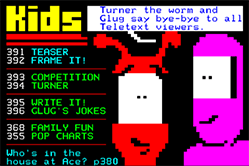
|
What was Turner The Worm?
Turner The Worm was the weekly teletext comic strip written and drawn by Paul Rose (Mr Biffo). Its serialised stories starred the titular limb-bearing worm and his friends, and was a permanent fixture on Teletext's Kids pages.
Aside from the Biffo connection it had nothing to do with Digitiser – they were separate sections, aimed at different audiences. Turner wasn't a Digitiser character.
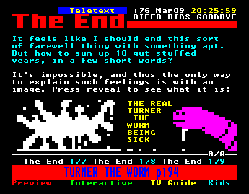
|
But then. Then came Digitiser's final edition – and the image that it will forever be associated with.
Yes, Digi bowed out on Teletext with a picture of a garish spunking cock as a reveal-o-joke – dubbed 'The Real Turner The Worm Being Sick'.
This image has now passed into immortality – and miraculously, didn't receive a single viewer complaint.
Who did Digitiser's graphics?
Paul Rose (Mr Biffo) was responsible for Digitiser's visual style, producing all of its graphics and designing its characters. He was hired by Teletext Ltd as a graphic designer, and created much of the service's look and feel.
When he and Tim Moore created Digitiser, Rose progressed to writing content as well as producing graphics – the two mediums being melded together to form Digi's freewheeling, anarchic style.
Did Digitiser have any catchphrases?
Why, yes it did – quite a few, in fact. Here are the main ones:
- - Best work yet – Said in reply to a viewer's letter if it met with approval, although somewhat tongue in cheek
- - Do you see? – Often used after making an off-kilter joke, obtuse reference, or as part of a withering reply to a particularly foolish reader on the letters page
- - Got and game! – Man stand-in/disguise Pat Walker's regular sign-off in his diary entries
- - Huss! – Exclamation of extreme disapproval, sometimes only for effect, and nothing to do with the fish
- - I cuss you bad – Main catchphrase of popular characters The Snakes
- - Moc-moc-a-moc! – Gibberish nonsense-phrase exclaimed with joyful exuberance by various strange reveal-o-characters
- - Nubbynubbynub! – Early catchphrase of The Man With A Long Chin, only used during 1993
- - Nun-nun-chal!/Chal-na-ha!/Chal-ning-ning! – Various exclamations by The Man's arch enemy The Fear Taunter/Man Who Taunts Fear
- - Press reveal – Instruction to press the reveal button on the remote control of teletext TVs, in order to reveal a joke, character, or something unexpected
- - Stay away from my bins! – Angry cry of Mr T
- - Swayze! – Meaningless exclamation, used at random in various reveal-o-jokes
- - wAReZ rULeZ!!! – Intentionally spelt like the author has had a stroke, this was the catchphrase of the character Computer Boy, and sometimes used in replies to letters. Referring to illicit cracked software sites, it was introduced after Mr Biffo was accosted on AOL Instant Messenger by an annoying child who kept repeating the idiotic phrase.
- - x-me-do – Used to describe something, e.g. "cuss-me-do"
- - You have messed-up – Said in reply to particularly foolish readers' letters
What does "Moc-moc-a-moc!" mean?
"Moc-moc-a-moc!" is one of Digitiser's best-known catchphrases. Completely nonsensical, it has no particular meaning, or is used in any particular circumstances - it's a gibberish phrase exclaimed with joyful exuberance by various strange reveal-o-characters, and has become a cornerstone of the Digitiser lexicon.
It originated in 1998 when a reader asked Digi to draw a swan on the letters page, but what appeared seemed to be a mutant swan on steroids - crying out the now-famous call, and giving birth to a legend.
What does "Huss!" mean?
Nothing to do with the fish, "Huss!" is an exclamation of extreme irritation and disapproval, though only ever meant semi-seriously.
What does "press reveal" mean?
Most teletext-enabled TVs had a button on their remote control labelled 'reveal'. Pressing it would display hidden text or graphics on the teletext page being viewed, overlaid on previously empty space.
This function was mostly used across teletext services in quizzes or jokes, but Digitiser made it their own, and in so doing gave it a whole new reason to exist.
The use of the reveal button became an integral and defining feature of Digi – they quickly became synonymous with it, and the unhinged 'reveal-o-jokes' they would display.
What was unleashed was a torrent of surreal whimsy from the depths of Mr Biffo's id – no doubt perplexing to many, but to Digitiser's fans, this was one of the main attractions of the magazine.
You can see a whole parade of this weirdness on the reveal-o-page.
What is a Reversible Sedgewick?

|
The greatest invention since the wheel, and a cornerstone of modern life that we simply couldn't be without. Reversible Sedgewicks have a thousand uses, and they've directly affected the lives of every single one of us since the glorious day when they first arrived – it's now hard to imagine a world without them.
They made a fleeting appearance in the Paul Rose-written episode 'Sophie Ltd.' of Childrens ITV show My Parents Are Aliens. In the script, the miracle inventions are described as looking like coconuts on wheels with feathers and springs sticking out of the top - and that's exactly what the props team made.
Full packaging and advertising banners were also produced to accompany them, which are surely now considered collector's items.
Why do some characters have straps around their mouths?

|
No, they're not ball gags - they're references to certain mischief a young Mr Biffo would get up to with his friends. In his teens, Biffo and pals would go into London, or to gigs, all wearing pieces of cardboard over their mouths, secured with a strap around the back of the head. And on the pieces of card? Why, another mouth, of course! This would be drawn onto the card, and Biffo and entourage would then proceed to go about their business as if nothing was amiss.
By the time Digitiser came along, this was a well-established tradition, and Biffo decided to incorporate it into the design of some characters.
In his imagining, these are the characters' actual mouths, made of flesh, and if you were to pull them away from the face by the strap, a smooth fleshy carapace would be left behind it. Yet the strap-mouths would function the same as regular mouths, with anything passing through them being "transported" into the face, as if through a portal - even if the strap-mouth is pulled away from it, leaving a void of thin air in between.
What's the significance of 72%?
Digi notoriously scandalised a generation of Mega Drive owners in 1994 by awarding Sonic 3 the score of a 'mere' 72%. This act sent shockwaves through the games industry, and is still remembered today.
Were the Ring-sir! phone pranks real?
Yes, they were - all of them. The semi-regular weekend feature Ring-sir! provided transcripts of prank phonecalls Digi had made to unsuspecting games shops and the like. Biffo and Hairs enjoyed doing them so much that they even took to pranking in their spare non-Digi time, in one case using a text-to-speech generator to order pizzas ("this is my voicebox, don't hang up!"). You can read some of these escapades in the Ring-sir! archive.
Did Digitiser receive many letters from readers?

|
Over the years a number of regulars would grace the pages - some finding favour, while others were slapped down for their frequent mess-ups.
A few of the major players over the years were:
- Boogie - the most proific letter writer in all of Rhondda, and provider of many a readers' chart for Auntie Chapman to stroke
- Danny Boyd - the Luton area's most made-up letter writer, he was in fact Digi all along, being used as a device to stoke debate and indignation
- Dantendo - frequently prone to mess-ups, and a very strange individual: actually changed his name to Dantendo by deed poll, and after suffering an apparent breakdown, sent faeces-smeared letters to Digi and accused them of trying to read his mind
- Fruitbat (Miss) - early acolyte of The Man With A Long Chin
- Patrick Grady - the Inverness native's letters were always welcomed, and Digi seemingly missed him when he didn't write
- The Girl With The Golden Game Boy - superstar correspondent of Digi's early days, rarely failed to feature on the letters page announcing her love for The Man With A Long Chin
- Stuart N Hardy - Digi's most notorious regular, the King of the Mess-Ups himself - Hardy's reputation spread far and wide. A serial letter writer to scores of UK publications, his primary motivation was to win prizes, and over the course of nearly a decade he was never dissauded by the constant abuse Digi fired at him in reply
- David O'Conner - like Hardy an Amiga fan from Sheffield, and also like Hardy, "Des" was very susceptible to mess-ups - though not nearly of the same magnitude
- Poppy - sent explicit love letters to The Man With A Long Chin drenched in perfume, and gained quite a fanclub in the process
- Scott Ross - one of the more coherent of Digi's regular correspondents, the Angus double-name wrote to Digi for many years
- Alex Seymour - a prolific correspondent and long-time Digi devotee, Seymour became known for signing off every letter with the words "That is all. I read you every day".
What was Digigate?
'Digigate' is the term that has come to be used to refer to the period from October 2001 to November 2002 when Teletext Ltd's management demanded that Digitiser be stripped of its humour and characters. Bosses wanted it to be written as a more 'straight' section, minus its idiosyncratic personality.
This era is regarded as a dark time in Digitiser's history, and was notable for the loss of around 800,000 viewers in response - more than half of the readership prior to the changes. Floods of letters were written by fans lamenting what had happened, and asking for Digi to be restored to its former glory.
Teletext eventually conceded they had made a mistake, and Digitiser's humour returned for a final few months before the section closed in March 2003. Paul Rose departed at this point, having felt the experience and eventual victory was a sign that it was now time to bring the curtain down on Digitiser and move on.
It was replaced on Teletext by the Tony Mott-written Game Central - a much more sedate, conventional publication.
Why did Digitiser end on Teletext?
Teletext Ltd had long viewed Digitiser with suspicion, and had managed to strip it of its humour for over a year during the 'Digigate' period of 2001-02. It was restored in November 2002, but the newly-found support of Teletext bosses always seemed fragile and tenuous – so, after this stressful period, when Biffo received word that further trouble was afoot in late 2002, he responded by offering his resignation.
Despite the fears being unfounded – Teletext were in fact intending to expand the section, not cut it back again – it was this act that lead to Biffo realising in his heart that it was time to call an end to Digitiser after all. Digitiser was last broadcast on 9 March 2003, before the section was rebranded as Game Central, with new writers, a more sober air, and no connection to Digitiser aside from using the same page number.
Why did Teletext dislike Digitiser?
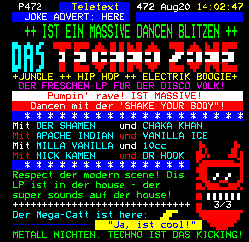
|
The duo became instant partners in crime after they were put on Team Digi together, giggling and messing about in the office, playing practical jokes, and not taking things at all seriously. Combined with the irreverent, nonsensical nature of much of their broadcast output, this resulted in Teletext management seeing them as trouble.
To begin with, under Teletext's original management, things were markedly different – they were considered golden boys, even dubbed the 'saviours of Teletext'. The fact that Digitiser was so popular, and Biffo was deemed essential for his graphics skills, meant that in the early days they were afforded a degree of protection, and pretty much arsed about with impunity.
Following a change of editorial director, however, things swiftly changed. Such was the antipathy towards them, that on a training day a colleague responded - when asked what they'd do in the event of a royal skiing accident - that they'd check Digitiser "to see if they'd made any sick jokes about skiing".
It shocked the Digi team to discover this was the way their colleagues viewed them, and highlights how misunderstood both it and its writers were by management.
Digitiser's humour was never mean-spirited, self-consciously edgy, or needlessly provocative (most of the time). But having gained a reputation for being a maverick section to be watched like hawks, the many sub-editors that came and went over the years were increasingly wary and suspicious of Digitiser's writing.
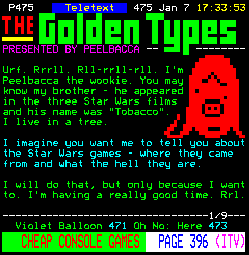
|
They saw innuendo and hidden jokes where there were none, to the point of paranoia, and even irrational outbursts. Innocent quips about 'fingering the index' (suspected of being a euphemism; in fact just a reference to the index page and finger), or mentions of the 'three Rs' (perceived to be a concealed 'arse') were cut, but other more overtly risqué jokes made it to air undetected.
One weary sub pleaded with Digi to pull a weekend page as she was convinced it contained hidden innuendo, asking them to just run it the following week when it wasn't her responsibility to check it.
Another, who would go on to play a key role in Digi's humour being removed, unilaterally cut almost an entire page without it being replaced with revised copy, leaving a confusing, largely blank page.
All new sub-editors were warned about Digi when they joined, and told to keep a close eye on them.
It was ironic that for Digitiser's first few years Mr Hairs was seen as the harmful influence leading an impressionable Biffo astray, when in fact their antics were very much a team effort. Biffo was also a permanent member of staff, while Hairs was a contractor, making Hairs the main target of Teletext's plots against Digi – culminating in his spurious sacking in April 1996 while Biffo was on paternity leave.
Why did Mr Biffo disappear?
By the late 2000s, around five years after the end of Digitiser, Paul Rose became disillusioned with his Mr Biffo alter ego. He was tired of writing about games, and the online community that had previously been so supportive was now only a source of stress and bickering (even stalking and threatening behaviour). On top of this, he was going through a difficult period in his personal life.
All this combined to make the Mr Biffo persona feel suffocating for him. Without fuss or any kind of announcement, he quietly walked away for the sake of his health, and concentrated for the next few years on his screenwriting career instead.
Why was Digitiser 2000 launched?
By November of 2014, Paul Rose had been away from the games industry and his Mr Biffo persona for nearly seven years. He had begun to realise that he now missed writing about games, missed Digitiser, and craved writing something that wasn't scripts for his day job.
Inspired by seeing the real-life inspiration for Digitiser character Cyber-X's incongruous new career as a self-help guru, he wrote a new Cyber-X piece, imagining where the character would be now.
Initially not knowing what to do with this material, he eventually posted it online, and was immediately met with a rapturous reception for his perceived return.
There was no grand plan, but within a short space of time a website was tentatively launched that went onto to become a full-blown Digitiser revival. Digitiser 2000 saw Biffo return to writing about games in a blog format, interspersed with the welcome return of classic Digitiser characters and various other silliness.
Along with these posts, he delved into his own and Digitiser's histories, publishing extensive memoirs lifting the lid on the Teletext years, what led to them, and what came after.
This new web incarnation of Digi gave Biffo the outlet he craved, and became a springboard for him to launch a number of other creative projects.
The rebirth of Digitiser was an unexpected gift, bringing its strange world to a whole new generation of passionate fans, and delighting returning veteran Digiphiles. While no longer online, the site is still available via the Wayback Machine.
What is Digitiser The Show?
Digitiser The Show is a popular YouTube-based TV show, conceived, written, and presented by Mr Biffo with various comedy and retro-gaming content creators. It was launched in 2018, funded by a hugely successful Kickstarter campaign, and aimed to return '90s-style gaming TV to our screens, with a huge dollop of Digitiser silliness on top. A second series was produced in 2023 to coincide with Digi's 30th anniversary.
Are there any big-name fans of Digitiser?
In the very early days, Bad Influence TV presenter Violet Berlin was Digi's most high-profile advocate, helping out the writers and providing a weekly column. Since then, a love of Digi has also been expressed by writer and director Alex Garland (The Beach, 28 Days Later, Ex Machina), who wrote a fitting tenth anniversary Digi tribute; musician J Willgoose Esq from (excellent) band Public Service Broadcasting, who appeared in an episode of Mr Biffo's Found Footage; and comedy actor Peter Serafinowicz (Look Around You, The Tick, the voice of Darth Maul in Star Wars Episode I).
Who owns Digitiser?
Mr Biffo – Paul Rose – owns the Digitiser trademark, having registered it unopposed by Teletext in early 2018.
Where can I contact the Digitiser writers?
You can write to Mr Biffo by emailing digitiser2000@gmail.com, and both Mr Biffo and Mr Hairs are active on social media.
Where can I learn how to recover teletext?
There are various guides and resources online - everything you need is below. Don't forget the VCR!
Alistair Buxton's GitHub - the original recovery software
Andrew Nile's teletext recovery blog
ZX Guesser's Adventures in Teletext Recovery
The Teletext Archaeologist's software guide
I have some old video tapes that might contain Digitiser, can I send them anywhere for recovery?
Thank you! You can indeed – teletext recovery heroes Andrew Nile and Jason Robertson both accept donations. Contact them to find out where to send your tapes. Hopefully they hold many lost Digi treasures!
Why is this website called Super Page 58 when teletext pages were 3 digits long?
It's named after a recurring Digi trope, where various things over the years were described as SUPER <THING> <NUMBER>. I chose 'page' rather than 'site', 'webpage', or 'website' because they were either too alliterative or simply didn't sound very good. The number 58 was chosen entirely arbitrarily. And that's all the story of that.
When was this website created?
It first went live on 9 December 1997, as part of a minor university assignment that got slightly out of hand.
Who runs this website?
A little guy by the name of Chris Bell, sometimes referred to as Bellston by youse guys. That's him writing this – hello!
Why are you running a Digitiser fansite?
Well, why not? Initially, when Digi was still on air, it was simply a way of paying tribute to something I loved. Since the site relaunched in February 2018, however, it's been primarily about wanting to document a phenomenon, and record as much as possible about a niche, but significant in its way, part of '90s UK culture for posterity.
As someone who'd been running one of the foremost Digitiser tribute sites during the Teletext era of Digi – and with my knowledge and memory of it – I saw it as a responsibility to resume that role. Understanding and recording as much of Digitiser's strange life as possible for historical, as well as entertainment purposes, is a mission I have gladly accepted, and will continue to "discharge" these solemn duties to the best of my ability.
How can I contact this website?
If you'd like to drop Super Page 58 a line, you can do so by emailing superpage58@gmail.com, or on Bluesky, by messaging @superpage58.bsky.social.
Are there any other Digitiser fansites?
There were a clutch of other fansites during Digi's halcyon Teletext days, but they're all extinct now. Limited archives exist of many of them, which can be viewed via archive.org, though coverage varies:
Digi-Me-Do
Digitiser Cartoon Strip Generator
Digi!
Do You See?
Page 670
Is there a Digitiser online community?
There certainly is, and it's very friendly and welcoming to newcomers too. It mostly centres around Mr Biffo's Bluesky and Patreon accounts, but there's also a Discord server, sub-Reddit, and Mr Biffo's Facebook page. The #digi IRC channel still regularly gets together for a chat too (you can connect to it using the mibbit client, or in-browser).
The newsgroups alt.digitiser and alt.digitiser.snakes still exist, though are pretty much dead aside from spam these days.
And of course, there's the Super Page 58 Bluesky account for site news and the latest Digi finds.
Where can I learn more about Digitiser?
Super Page 58 has an exhaustive array of information about Digi:
- What Is Digitiser?
- Digitiser Timeline of Events – the complete history as it unfolded
- The Digitiser/Mean Machines Sega Feud – a detailed look at the print-based fisticuffs
- Do You See? – the comprehensive Digitiser encyclopaedia
- The Digitiser Vault – over 45,000 pages from around 1,600 editions of Digi
- Edge magazine feature on Digi
- Retro Gamer magazine feature on Digi
- Digitiser Characters A-Z
- Digitiser The Show: Secret Origins Of Digitiser
Plus, Mr Biffo revealed huge amounts of detail about Digi in his sort-of-memoirs published on Digitiser 2000:
- Games of My Years: 16-BIT Part 1
- Games of My Years: 16-BIT Part 2
- Games of My Years: Digitiser Part 1
- Games of My Years: Digitiser Part 2
- Games of My Years: Digitiser Part 3
- Games of My Years: Digitiser Part 4
- Games of My Years: Digitiser Part 5
- Games of My Years: Digitiser Part 6
- Games of My Years: Digitiser Part 7
- Games of My Years: Digitiser Part 8
- Games of My Years: Digitiser Part 9
- Games of My Years: Digitiser Part 10
- Games of My Years: Digitiser Part 11
Do you know of any important moments from the annals of Digi history that have been omitted? If so, then mail me (superpage58@gmail.com) right now, man. Credit will be duly given for anything that gets put up.


